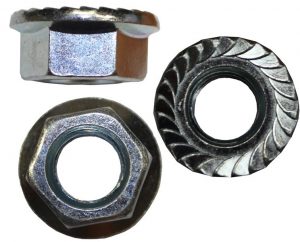
Nuts are often used when joining two or more objects together. They are fasteners with interior threading that work in conjunction with bolts. After inserting a bolt through the objects, you can twist a nut over the end of the bolt. The nut will compress the joined objects so that they don’t pull away from each other or otherwise become loose.
While all nuts work in conjunction with a bolt, they are available in different types. Flange, for instance, is a unique type of nut. Flange nuts still require the use of a bolt, but they feature a different design than most other nuts. What are flange nuts exactly?
What Is a Flange Nut?
A flange nut is a special type of nut that’s characterized by a flanged design. The term “flanged” refers to a protruding rim. All flange nuts have a protruding rim on one side. One side looks like a traditional nut, whereas the other side has a protruding rim.
The protruding rim on flange nuts essentially acts as a built-in washer. Washers are fasteners as well. And like nuts, they are typically used in conjunction with bolts. Rather than using a traditional nut with a separate washer, though, you can use a flange nut. Flange nuts have a protruding rim that serves the same purpose as a washer.
How Flange Nuts Work
With their protruding rim, flanged nuts are exposed to a larger surface area than traditional nuts. When you install a nut, it will press against one of the objects. Flange nuts will press against a larger surface area of the object than traditional nuts because of their protruding rim.
To join multiple objects together with a bolt and nut, you’ll have to drill a hole through the objects. With that said, some objects may have an oversized hole. In other words, the hole may be too large to accommodate a traditional nut. Twisting a nut over the end of the bolt may cause it to slip into the oversized hole. In cases such as this, a flange nut may offer a solution.
Flange nuts are often used in fastening applications involving oversized holes. They have a protruding rim that covers more surface area. Even if the hole is too big for a traditional nut, it may support the use of a flanged nut. At the same time, the flanged nut will distribute the load more evenly thanks to its protruding rim.
